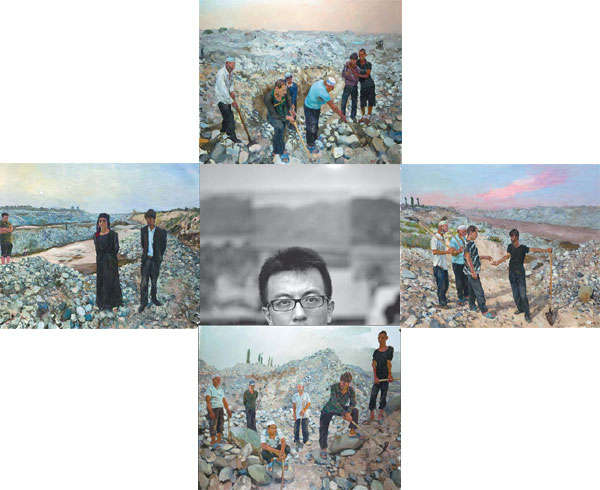Liu Xiaodong: Unknown horizons
 0 Comment(s)
0 Comment(s) Print
Print E-mail China Daily, January 25, 2013
E-mail China Daily, January 25, 2013
|
|
|
Liu Xiaodong continues to focus on ordinary people's lives in his latest works, (clockwise from top) North, East, South and West. Photos Provided to China Daily |
A painter captures the lives of jade diggers on a journey to the western lands of Xinjiang.
The tan on Liu Xiaodong's face still reflects the strong sunshine and sandstorms of Hotan. In June last year, the 49-year-old leading Chinese artist began a two-month art project in the city in the south of the Xinjiang Uygur autonomous region. He set up a temporary tent in the Gobi Desert as his painting studio, and had several local jade diggers modeling for his painting.
The sandstorm there made the project almost impossible. "The sand was all over the canvas and the paint was like being mixed on sand paper," Liu wrote in his diary on July 6.
The artist eventually completed four large paintings in his shaky tent, a process that has been documented by a small film team.
After being exhibited last August in Urumqi, the artworks are now in Beijing along with the finished documentary and Liu's diaries written during the two months, as well as dozens of smaller works he has created since coming back to Beijing.
The four oil paintings are hung on a 14-meter-high wall in Today Art Museum. Titled East, West, South and North, the paintings feature scenes of the jade diggers life and work in the desert.
Instead of playing with the exotic and beautiful symbols usually associated with Xinjiang, Liu strictly transfers what he saw onto the canvas. That includes piles of Gobi stones, workers' ragged clothes and the grayish yellow sky.
"Liu's art is Dirty Realism," says Hou Hanru, the exhibition's curator.
"The so-called Realism in the usual sense is purified Realism, which has eliminated all the unharmonious and nonbeautiful elements," Hou explains. "Therefore, Realism is in some ways the most unrealistic, especially when it becomes an expressive formula of ideology and the projection of power."
However, "Liu retrieves everything that the clean-version Realism has abandoned, which makes the Realism real," he says.
By keeping the style "dirty", Liu has won a reputation for persisting in painting from real life. Such a way of painting distinguishes him from other vanguard contemporary Chinese artists and - at the same time - makes him very "contemporary".
"Chinese Realism and Chinese contemporary art have never interacted on real significance," comments Today Art Museum director Hsieh Su-chen. "Liu's work is a start."
But the artist does not actually give much thought to the way he paints.
"I just paint," Liu says.
He adds that he loves on-site painting because he loves the feeling of being on the road and accessing people and things he normally can't.
"The unknown is a good thing. You can always learn," the artist says.
For example, Liu found it was very inspirational listening to those jade workers sharing their opinions about religion and society during their lunch break, even if he heard just a few words.
A parallel project, launched by Hou and co-curator Ou Ning, contains historical studies, film screenings and seminars with local writers, musicians and craftsmen. Liu says he got to know many excellent Xinjiang writers for the first time.
This year, the artist's travels will stretch to Israel.
"I like to be an uncertain artist, waiting to explore more," Liu says.







Go to Forum >>0 Comment(s)